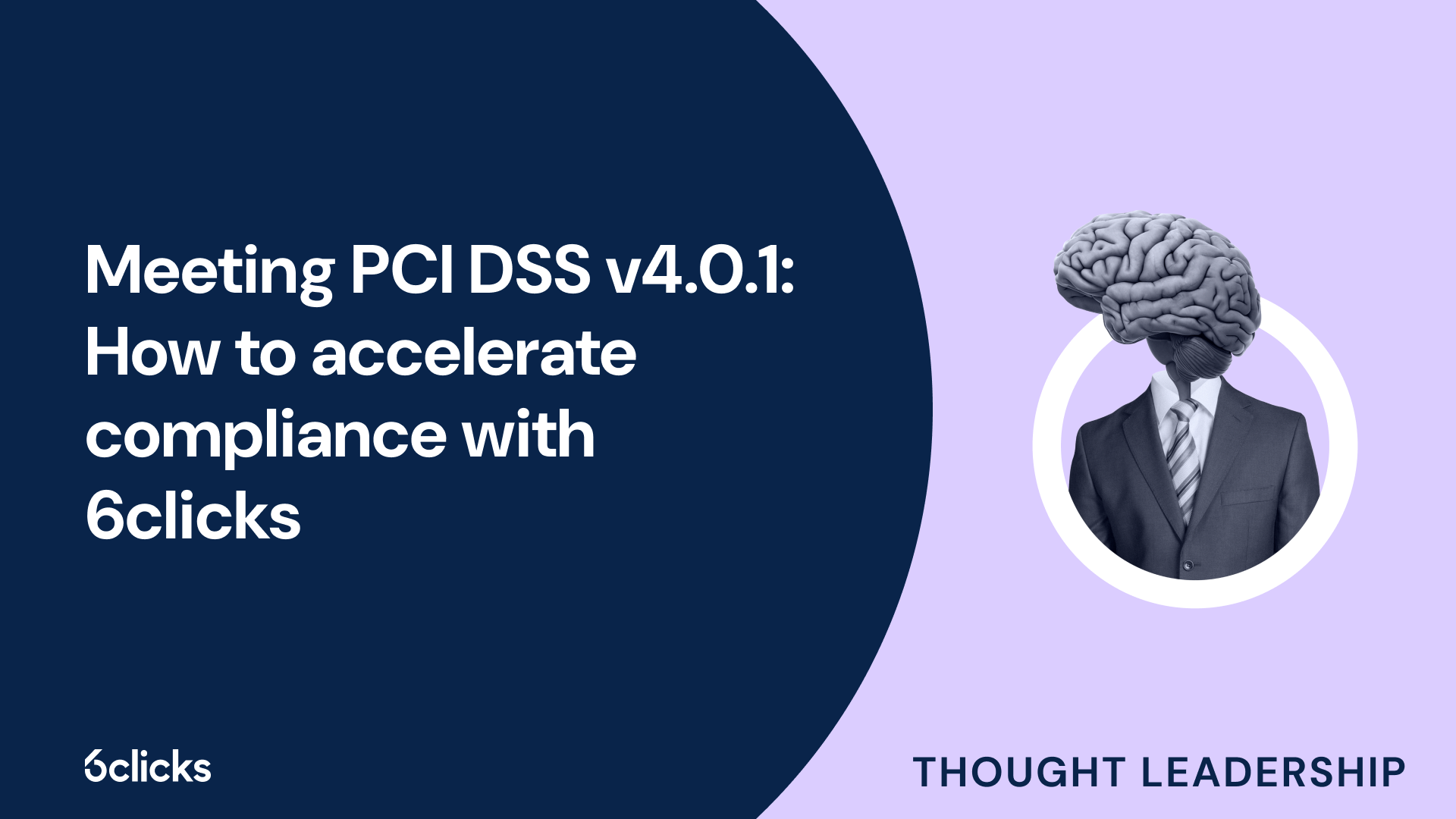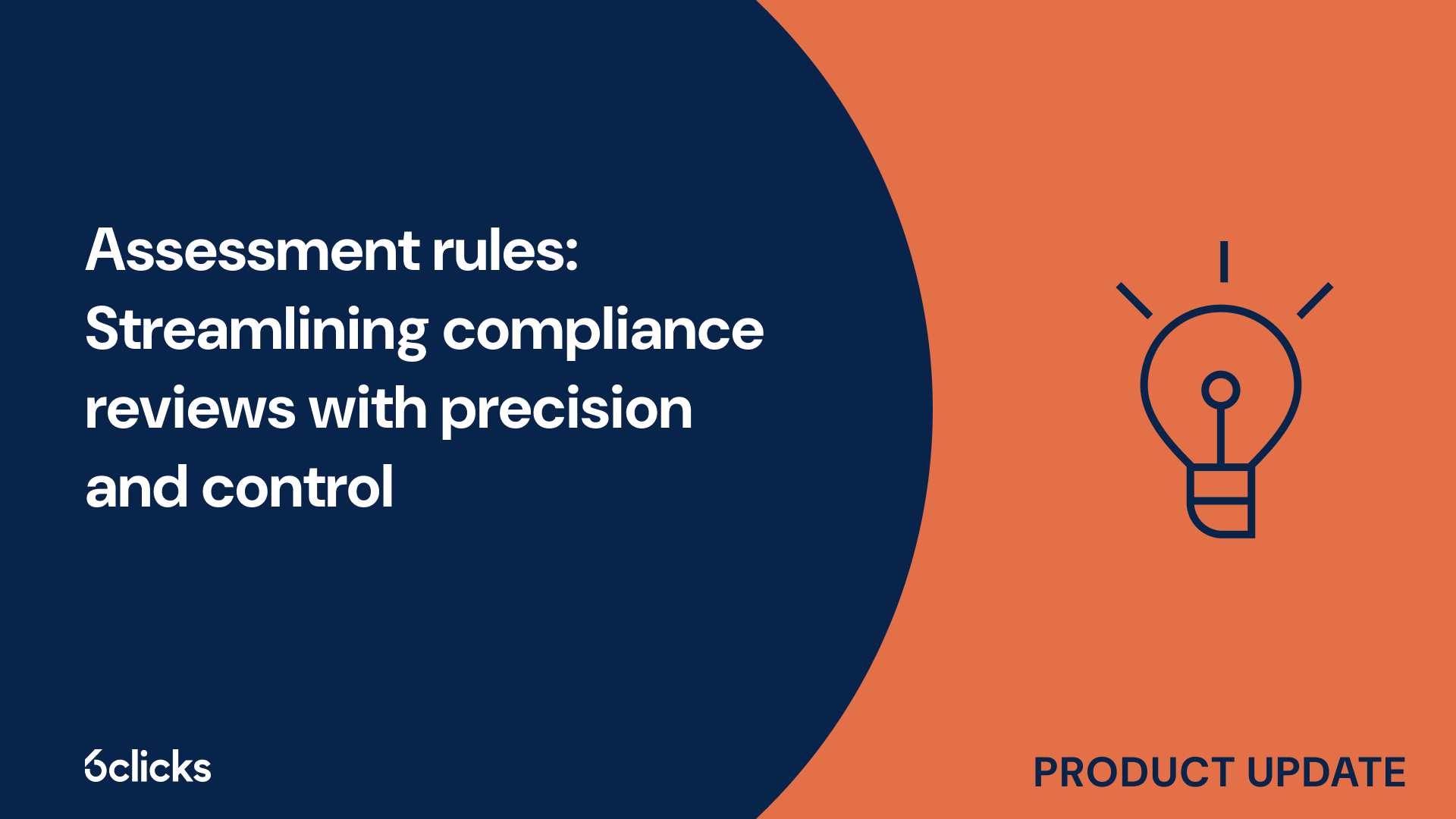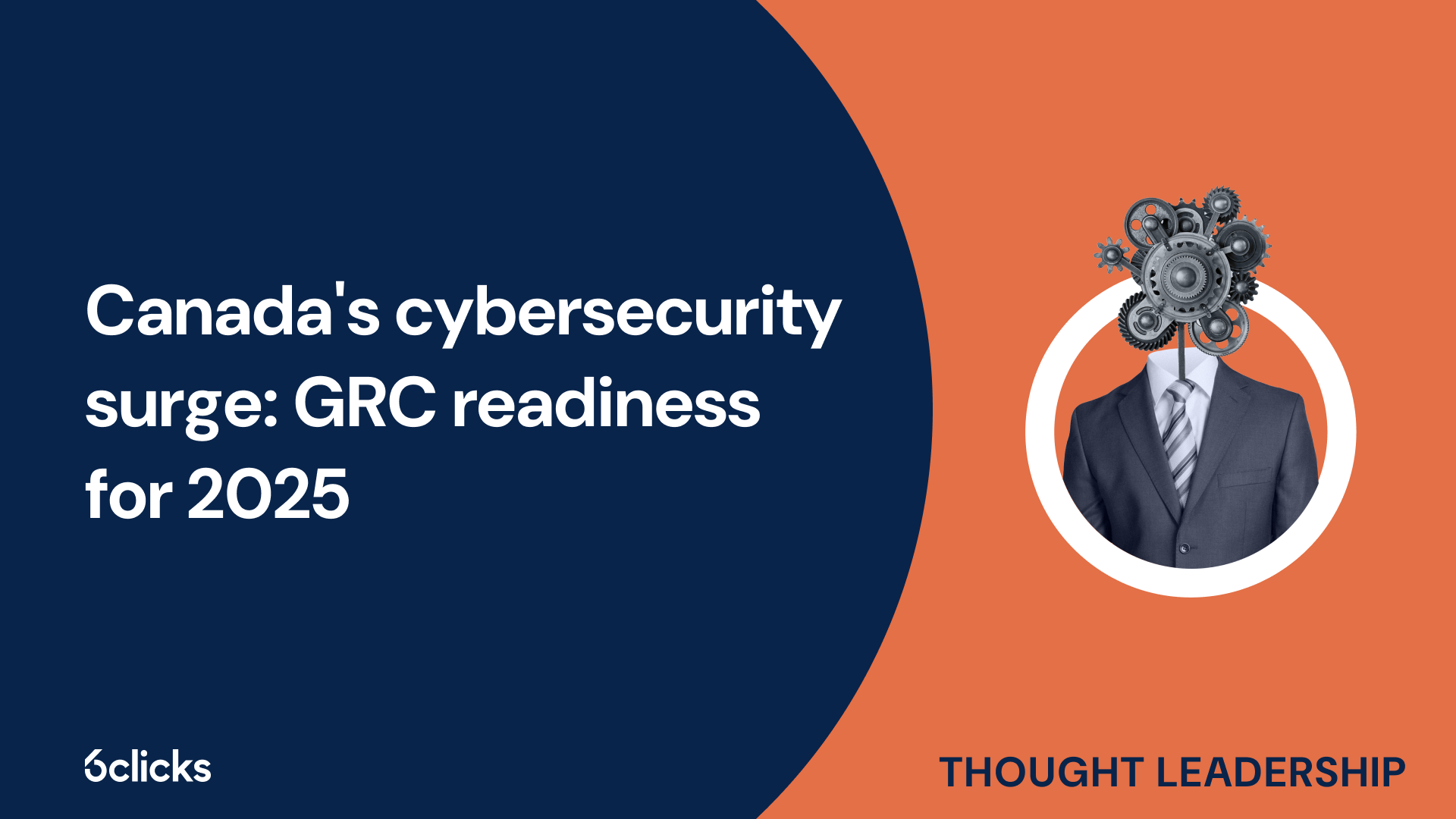The GRC buyer’s guide for 2025: Building resilience with AI-powered, federated solutions
Discover the ultimate GRC buyer's guide for 2025! Uncover how AI-powered, federated solutions transform compliance and security management for industries like government, aerospace, banking, and more. Learn about centralized control, continuous compliance, and advanced cyber GRC capabilities. Download now!
-1.png?width=200&height=249&name=Group%20193%20(1)-1.png)
The GRC buyer’s guide for 2025: Building resilience with AI-powered, federated solutions
Definition of ERM
Enterprise Risk Management (ERM) is a structured and systematic approach to managing potential risks that may impact an organization's ability to achieve its strategic objectives. ERM seeks to identify, assess, mitigate, and monitor various types of risks, including financial, strategic, operational, and legal risks. It involves the entire organization, including the board of directors, senior management, and all levels of employees, to establish a risk management framework and processes that align with the organization's risk appetite and culture. ERM aims to enhance decision-making by evaluating potential impacts and opportunities associated with risks and implementing appropriate risk responses. ERM also considers external risks, such as natural disasters and regulatory changes, and incorporates them into the risk analysis and management processes. By adopting ERM, organizations can proactively address risks, improve performance, and ensure the achievement of business objectives and strategic goals.
Overview of steps in ERM
Enterprise Risk Management (ERM) is a continuous process that involves several core elements to effectively manage risks within an organization. The steps in ERM encompass a systematic approach to identify, assess, and respond to potential risks that can impact an organization's ability to achieve its strategic objectives.
The first step in ERM is risk identification. This involves identifying and categorizing various types of risks, such as financial risks, operational risks, legal risks, and reputational risks. It is crucial to understand the risk landscape and evaluate potential impacts on the organization's objectives.
After identifying risks, the next step is risk assessment. This involves analyzing the likelihood and potential impact of the identified risks. Risk managers utilize risk analysis tools and techniques to assess the level of risk exposure and prioritize risks based on their significance.
Once risks have been assessed, the organization needs to develop risk responses and management strategies. This entails determining the risk tolerance and risk appetite of the organization. Risk mitigation measures are then designed to reduce or eliminate the probability of risks occurring or the severity of their impact. Risk managers may also explore risk opportunities to capitalize on potential benefits that arise from certain risks.
ERM is an ongoing process that requires continuous monitoring and evaluation. Regular updates and improvements in the ERM program are necessary to incorporate changes in the risk landscape, business strategy, and organizational objectives. This helps ensure that the risk management framework remains aligned with the evolving needs of the organization.
By following the steps in ERM and maintaining an ongoing process, organizations can effectively manage risks, enhance decision-making, and safeguard their ability to achieve strategic goals.
Step 1: identify risks
Identifying risks is the crucial first step in enterprise risk management (ERM). This involves systematically recognizing and categorizing various types of risks that could potentially impact the organization's strategic objectives. These risks can include financial risks, operational risks, legal risks, reputational risks, and more. By thoroughly understanding the risk landscape, organizations can better assess the potential impacts and prioritize risks accordingly. Through this process, risk managers can gain valuable insights into the potential threats and opportunities that may arise, allowing them to develop effective risk mitigation strategies and capitalize on potential benefits. Ultimately, by identifying risks, organizations can proactively manage and navigate the uncertainties they face, facilitating informed decision-making and ensuring the achievement of long-term goals.
Types of risk to consider
In the enterprise risk management (ERM) process, it is crucial to consider different types of risks that could potentially impact a company's strategic objectives, operational efficiency, and financial stability. Based on the analysis of S&P 500 companies, three key types of risks are strategic risks, operational risks, and financial risks.
Strategic risks pertain to uncertainties in achieving business strategy and objectives. These risks arise from changes in market conditions, technological advancements, or shifts in consumer preferences. For example, a company might face strategic risks when entering a new market or launching a new product.
Operational risks refer to risks associated with the day-to-day activities and processes within a company. These risks can arise from system failures, human errors, supply chain disruptions, or regulatory non-compliance. An example of operational risk is a cyberattack that compromises sensitive customer data.
Financial risks are risks related to a company's financial health and stability. These risks could include fluctuations in currency exchange rates, interest rates, or credit risks. For instance, a company exposed to foreign exchange risk might experience financial losses due to unfavorable currency movements.
By considering strategic risks, operational risks, and financial risks, organizations can better identify potential impacts and develop risk management strategies to mitigate or exploit those risks. Effectively managing these different types of risk can help companies stay resilient and achieve their business objectives in an increasingly complex and uncertain business environment.
Establishing a risk framework
Establishing a Risk Framework in Enterprise Risk Management (ERM)
To effectively manage risks, organizations must establish a comprehensive risk framework within their Enterprise Risk Management (ERM) program. This framework provides a structured approach to identify, assess, and mitigate risks across all business units and ensure alignment with strategic goals. Here are the steps involved in establishing a risk framework:
- Define the Risk Framework: The first step is to define the risk framework, which includes establishing the objectives, scope, and governance structure. This involves defining the roles and responsibilities of the board of directors, senior management, and risk managers in overseeing risk management activities.
- Develop a Risk Identification Methodology: A clear and consistent risk identification methodology is crucial for effectively identifying risks across all business units. This involves developing a standardized approach to identify both current and future risks by conducting risk assessments, using techniques such as risk workshops, interviews, and data analysis.
- Determine Risk Calculation Factors: Once the risks are identified, organizations need to determine risk calculation factors such as probability and impact. By assigning values to these factors, organizations can prioritize risks based on their significance and develop appropriate risk management strategies.
- Record Risk Reporting in a Centralized Risk Register: To ensure effective risk management, organizations should maintain a centralized risk register. This register captures all identified risks, along with their associated details, such as risk category, potential impacts, risk responses, and risk owners. Regular reporting and updating of the risk register allows for continuous monitoring and evaluation of risks.
By following these steps, organizations can establish a robust risk framework in their ERM program. This framework will enable them to proactively identify, assess, and manage risks, ensuring alignment with strategic goals and minimizing potential adverse outcomes.
Assigning responsibility for risk identification
Within the ERM framework, assigning responsibility for risk identification is a critical step in effectively managing risks. To ensure accountability and a comprehensive understanding of potential risks, it is important to designate specific individuals or teams who are responsible for identifying and documenting risks.
Key individuals or departments within the organization should be identified to take on this responsibility. These individuals could include risk managers, department heads, project managers, or subject matter experts who have a deep understanding of the organization's operations and potential risks associated with them.
Clear communication and collaboration are essential in assigning responsibility for risk identification. The designated individuals or teams should have a clear understanding of their role and the expectations placed upon them. They should also have access to relevant resources, such as historical data, risk registers, and risk assessment tools, to support them in their identification efforts.
By assigning responsibility for risk identification, organizations ensure that risks are not overlooked or underestimated. This process allows for a comprehensive understanding of potential risks and enables proactive risk management measures to be put in place. Furthermore, accountability for risk identification promotes a culture of risk awareness and encourages individuals to actively contribute to the organization's risk management efforts.
Documenting the risks identified
During the enterprise risk management (ERM) process, documenting the risks that have been identified is a crucial step that ensures credibility and aids in the prioritization of risks. Thorough documentation is essential as it provides a comprehensive record of potential risks and helps in developing risk management strategies.
To document the identified risks, the ERM committee should utilize a systematic approach. This involves using qualitative analysis to assess the potential impact and likelihood of each risk occurring. Qualitative analysis helps in understanding the nature and characteristics of the risks, which is vital for effective risk management.
In addition to qualitative analysis, predictive analysis should also be employed to evaluate future risks. This involves analyzing historical data, emerging trends, and external factors to predict potential risks that may arise over time. By integrating predictive analysis into the documentation process, organizations can proactively address emerging risks and enhance their risk management capabilities.
The outcomes the ERM committee should aim to achieve during this step include developing a clear risk identification methodology. This methodology should outline the process of identifying and documenting risks, ensuring consistency and standardization across the organization. Additionally, the committee should establish a centralized risk register to record all identified risks. This allows for easy tracking and monitoring of risks and ensures that all relevant stakeholders have access to the information.
Step 2: analyze risks
Once the risks have been identified and documented, the next step in the enterprise risk management (ERM) process is to analyze them. This involves using both qualitative and predictive analysis techniques to gain a deeper understanding of the nature and characteristics of the risks. Qualitative analysis helps assess the potential impact and likelihood of each risk occurring, while predictive analysis evaluates future risks based on historical data, emerging trends, and external factors. By combining these analysis methods, organizations can proactively address emerging risks and enhance their risk management capabilities. The key outcomes of this step include developing a clear risk identification methodology to ensure consistency and standardization across the organization, as well as establishing a centralized risk register for easy tracking and monitoring of risks. This enables all relevant stakeholders to have access to vital risk information for effective decision-making and risk mitigation strategies.
Assessing potential impacts of identified risks
Assessing the potential impacts of identified risks is a crucial step in enterprise risk management (ERM). By considering the likelihood and financial impact of each risk, organizations can better understand the potential consequences and take appropriate measures to mitigate or manage them.
To assess the potential impacts, it is important to evaluate both direct and residual risks. Direct risks refer to the initial impact of an identified risk, while residual risks are the remaining risks after implementing risk management strategies. By considering both types of risks, organizations can gain a more comprehensive understanding of the potential outcomes.
Quantifying risks is also beneficial in assessing potential impacts. This involves assessing the percent change of occurrence and the dollar impact each risk may have on the organization. By assigning numerical values to these factors, organizations can prioritize risks based on their severity and allocate resources accordingly.
Assessing potential impacts allows organizations to determine the significance of each risk and make informed decisions regarding risk management strategies. It enables organizations to identify and prioritize risks that align with their strategic goals and objectives. Moreover, it helps organizations establish risk tolerance levels and develop appropriate risk responses.
Assigning probability and severity scores to each risk
In the enterprise risk management (ERM) framework, assigning probability and severity scores to each identified risk is a crucial step in analyzing and prioritizing risks. This process allows organizations to evaluate the likelihood and potential impact of each risk on their strategic goals and objectives.
To assign probability scores, organizations assess the likelihood of a risk event occurring based on historical data, industry trends, and expert judgment. Probability scores can be qualitative (low, medium, high) or quantitative (expressed as a percentage).
Similarly, severity scores are assigned to estimate the potential impact of each risk event on the organization. This involves evaluating the magnitude of financial, operational, and reputational impacts that could arise from the risk. Severity scores can also be qualitative (low, medium, high) or quantitative (expressed in monetary terms).
By assigning probability and severity scores, organizations can effectively analyze and prioritize risks. Risks with high probability and severity scores indicate potential significant impacts and thus require immediate attention. Conversely, risks with low scores may not warrant as much attention or resources.
Categorizing risks based on their probability and severity scores further assists in risk analysis and prioritization. Risks can be classified into categories such as high, medium, and low based on their overall scores. This categorization helps organizations identify the most critical risks that pose significant threats to their strategic objectives and allows for focused mitigation efforts.
Assigning probability and severity scores and categorizing risks not only aids organizations in understanding their risk landscape comprehensively but also enables them to develop effective risk management strategies and allocate resources appropriately.
Prioritizing risks based on potential impact and probability of occurrence
Prioritizing risks based on their potential impact and probability of occurrence is a crucial step in effective risk management. To prioritize risks, organizations need to assess the potential impact of the risks and the likelihood of them occurring.
To start, organizations should conduct a thorough analysis of each risk's potential impact. This involves evaluating the magnitude of financial, operational, reputational, and strategic impacts that could arise from the risk event. By quantifying the potential impact, organizations can gain a clearer understanding of the risks that could have significant consequences for their objectives.
Next, organizations should evaluate the probability of each risk occurring. This can be done by considering historical data, industry trends, expert judgment, and other relevant information. By assigning probability scores, organizations can determine the likelihood of each risk event happening.
Once the potential impact and probability scores are assigned, organizations can rank the risks accordingly. Risks with high potential impact and high probability scores should be given top priority as they pose the greatest threat to the organization. Conversely, risks with low potential impact and low probability scores may be considered lower priority.
Prioritizing risks allows organizations to allocate resources and attention to the most critical risks. It helps them focus on mitigating the risks that are likely to have the most significant impacts on their strategic objectives. By using risk management solutions that provide different categories of risks, organizations can further streamline the prioritization process and ensure that all aspects of risk are adequately addressed.
Step 3: evaluate risks
After identifying and categorizing risks in enterprise risk management (ERM), the next step is to evaluate the risks. This step involves assessing the probability and severity of each identified risk to determine their potential impact on the organization.
One commonly used methodology for evaluating risks is through risk control self-assessment (RCSA). In this method, employees within the organization evaluate the risks associated with their respective areas of responsibility. They assess the likelihood of each risk occurring and the potential severity of its impact. By involving employees in risk assessment, organizations gain valuable insights and ensure a comprehensive evaluation.
Another effective tool for risk evaluation is the risk assessment matrix. This matrix helps in visualizing the probability and severity of risks, enabling organizations to assign risk levels based on these factors. The matrix usually categorizes risks into low, medium, and high levels based on their probability and severity scores.
To ensure a comprehensive risk evaluation, organizations should review their assets and conduct a risk analysis. This involves scrutinizing various aspects of the organization, identifying vulnerabilities, and potential harm to the organization. By conducting a thorough analysis, organizations can gain a deeper understanding and prioritize risks accordingly.
By evaluating risks through methodologies such as RCSA and utilizing tools like the risk assessment matrix, organizations can make informed decisions on risk management strategies. This step is crucial in determining the severity of risks and enabling organizations to take appropriate actions to mitigate or respond to these risks. Overall, evaluating risks is an essential component of effective enterprise risk management and ensures the organization's goals and objectives are protected.
Step 4: monitor and review risks
After evaluating the risks in enterprise risk management (ERM), the next crucial step is to effectively monitor and continually review the identified risks. Monitoring and reviewing risks involves developing a structured process to ensure ongoing surveillance and assessment of the risks faced by the organization. This step enables organizations to proactively identify any changes in risk levels, assess the effectiveness of risk management strategies, and promptly respond to emerging risks. By establishing a robust monitoring and review mechanism, organizations can stay ahead of potential threats, make informed decisions, and ensure the adequacy of their risk management efforts. Regularly assessing and evaluating risks also helps organizations to adapt their risk management strategies to the ever-changing business landscape and ensure the achievement of strategic objectives.
Reassessing goals and objectives periodically
Reassessing goals and objectives periodically is a critical component of an effective Enterprise Risk Management (ERM) framework. This process ensures that an organization's strategic goals and objectives remain aligned with its risk appetite while considering any changes in the business environment.
The importance of reassessing goals and objectives within the ERM framework cannot be overstated. It enables organizations to identify and manage potential risks that may affect their ability to achieve their strategic goals. By regularly reviewing and reevaluating objectives, organizations can proactively identify and respond to emerging risks, both internal and external, in a timely manner. This helps in minimizing potential impacts on the organization's financials, reputation, and overall performance.
The steps involved in reassessing goals and objectives in the ERM framework typically include:
- Evaluating the current goals and objectives set by the organization.
- Identifying the key risks that may hinder the achievement of these goals.
- Assessing the alignment between the identified risks and the organization's risk appetite.
- Reviewing and revising the goals and objectives in light of the identified risks and risk appetite.
- Developing and implementing risk management strategies to address the identified risks and ensure alignment with the revised goals and objectives.
- Monitoring and regularly reviewing the progress and effectiveness of the risk management strategies.
By following these steps, organizations can ensure that their goals and objectives are periodically reassessed and aligned with their risk appetite. This proactive approach to risk management enhances the organization's ability to navigate uncertainties, seize opportunities, and achieve its strategic goals while minimizing potential risks.
Step 5: communicate the results
Effective communication is a crucial element in the Enterprise Risk Management (ERM) process. It ensures that stakeholders are informed of risks, risk management actions, and processes, creating awareness of specific risks associated with business functions. By communicating the results, organizations can enhance their understanding of the risks they face, gain support for risk management initiatives, and foster a culture of risk awareness and accountability.
Firstly, communicating risks to stakeholders is essential for transparency and accountability. It enables organizations to inform key stakeholders, such as the board of directors, senior management, and employees, about the risks identified and their potential impact on the achievement of objectives. This helps stakeholders understand the need for risk management actions and allocate appropriate resources to mitigate the identified risks.
Secondly, communicating risk management actions and processes is crucial for ensuring the effectiveness of risk management strategies. By clearly articulating the actions taken to address identified risks, organizations can demonstrate their commitment to managing risks proactively and effectively. This helps in building trust and confidence among stakeholders and enhances the organization's overall risk management efforts.
Lastly, creating awareness of specific risks associated with business functions is essential for fostering a risk-aware culture throughout the organization. By communicating the results of risk assessments and highlighting the specific risks associated with different business functions, employees can better understand their role in risk management. This empowers them to identify and report risks promptly, leading to enhanced risk identification and mitigation efforts across the organization.







